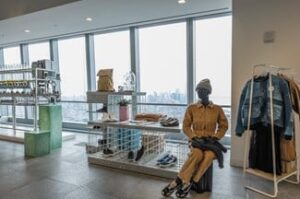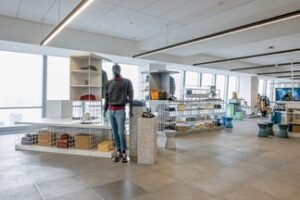When’s the last time you spoke to a friend about a product, only to see it advertised on Instagram moments later? Or the last time you opened an e-mail from your favorite store with personalized product recommendations that seemed to know your exact preferences when it comes to color, style, and size? As a businessperson, and as a consumer, you know that personalization heavily influences loyalty, engagement, and revenue.
Over the past decades, the fashion industry underwent a technological revolution, reshaping the way retailers and brands engage with their customers. Personalization lies at the center of this transformation. By customizing the shopping experience for consumers, retailers stand out from their competition and foster greater customer loyalty. Seventy-six percent of consumers say personalization directly influences their decision to purchase from a brand, and 78% say it impacts their likelihood of making repeat purchases and referring the brand to friends and family.
Historically, fashion retailers relied primarily on traditional marketing techniques, such as print advertisements and in-store displays, to attract customers. However, with the rise of e-commerce and the Internet, customers now want and expect a personalized shopping experience that meets their individual needs and preferences. Customers are looking for seamless integration across multiple channels, including brick-and-mortar stores, online Web sites, mobile apps, and social media.
Omnichannel retail provides customers with the flexibility to shop whenever and wherever they want, and it provides businesses with in-depth data on customers’ shopping habits and preferences. With this information, fashion retailers can build a comprehensive profile of each customer, which can then be used to create targeted marketing campaigns, product recommendations, and personalized shopping experiences. Artificial intelligence (AI) and machine learning also enhance the customer experience. By analyzing customer data, AI can predict the likelihood of a customer making a purchase, offer real-time suggestions, check in post-purchase, and follow up for customer feedback. Enhanced customer understanding leads to better marketing decisions and better business outcomes.
SAP solutions play a prominent role in the execution of timely and impactful personalization, connecting customer data from demand to delivery and bringing sustainable, intelligent enterprises to life – from the back office to the front office.
Dive deeper into five solutions shaping the future of customer experience – in fashion retail and beyond.
- SAP S/4HANA Retail: SAP S/4HANA Retail can store all the data needed to deliver exceptional customer experiences, providing the foundation for the rest of the solutions and bringing the overall experience to life. With real-time customer and sales information, businesses can connect and transform retail processes across the entire value chain.
- SAP Emarsys Customer Engagement: This omnichannel customer engagement platform can empower marketers to build, launch, and scale personalized cross-channel campaigns that scale business outcomes. The platform helped Puma scale its marketing and customer relationship management (CRM) operations to identify and target high-value segments and grow the CRM database. It also matches in-store and online data to enhance its customer identification capabilities.
- SAP Commerce Cloud: This solution can provide businesses with a trusted e-commerce platform that unlocks innovation at scale. With access to enterprise-wide data, retailers can boost profits and customer satisfaction. With SAP Commerce Cloud, Carhartt created a unified e-commerce platform that connects customers to the right products faster than ever – reducing the loading time of pages from seconds to milliseconds, which results in fewer customers abandoning items in their shopping carts. It also provides data insights that help Carhartt’s merchandising team optimize its product placement strategy.
- SAP Customer Data Platform: With enterprise-wide customer insights from SAP Customer Data Platform, businesses can meet customer expectations by delivering personalized engagements while also increasing conversion and improving customer retention. Take millennials and Gen Z shoppers for example, which represent US$600 billion in purchasing power. These groups show growing interest in sustainable products. With the right technology, retailers can capture more detail around their sustainability preferences and shopping habits and then use the data to make sustainability transparent across their value chains and improve the customer experience in the process. Ferrara Candy Company uses SAP Customer Data Platform to dig deeper into its consumer base. With greater insights into consumer behavior, Ferrara discovered a strong link between its Trolli brand and gamers. Ferrara used this information to shape future promotions and sweepstakes. With deeper knowledge of its customers, Ferrara created a brand fan program and significantly increased earned media value.
- SAP Intelligent Returns Management: Turn the challenge of returns into an opportunity with SAP Intelligent Returns Management, an industry cloud solution from SAP. It can not only make the returns experience easy, flexible, and free for customers, it can also protect your business’ bottom line and improve customer retention. Gain insights around the kind of products that are selling and those that are not. With a more granular look into the colors, styles, and sizes of items that customers return, the business can make more sustainable decisions about design and production.
Curious how your business can leverage the full potential of these five solutions, and others, to improve your customers’ experiences and drive long-term business success?
On February 15th, during New York City’s Fashion Week, SAP opened the doors of the redesigned SAP Experience Center, home to the S.Fashion Experience Lab. During the opening event, Andre Bechtold, senior vice president and head of Solution and Innovation Experience at SAP, shared that, “SAP Experience Centers offer visitors a visual and immersive experience that makes innovation tangible.” From a personalized perfume machine and augmented reality (AR) displays to virtual fitting rooms and AI-powered personal shopping assistants and robotics, the retail store of tomorrow reimagines the future of fashion.
Visit this permanent location year-round, physically or virtually, to discover how SAP helps retailers optimize their businesses and connect with their customers in a digital-first world. Deep dive into the solutions above, along with many others, to learn how you can offer unique and personalized customer experiences that reinforce long-lasting customer relationships and grow lifetime value for your business.

Kelly Cannon is part of Content Creation and Strategy at SAP.
Images via Andreas de Groot, Purple





